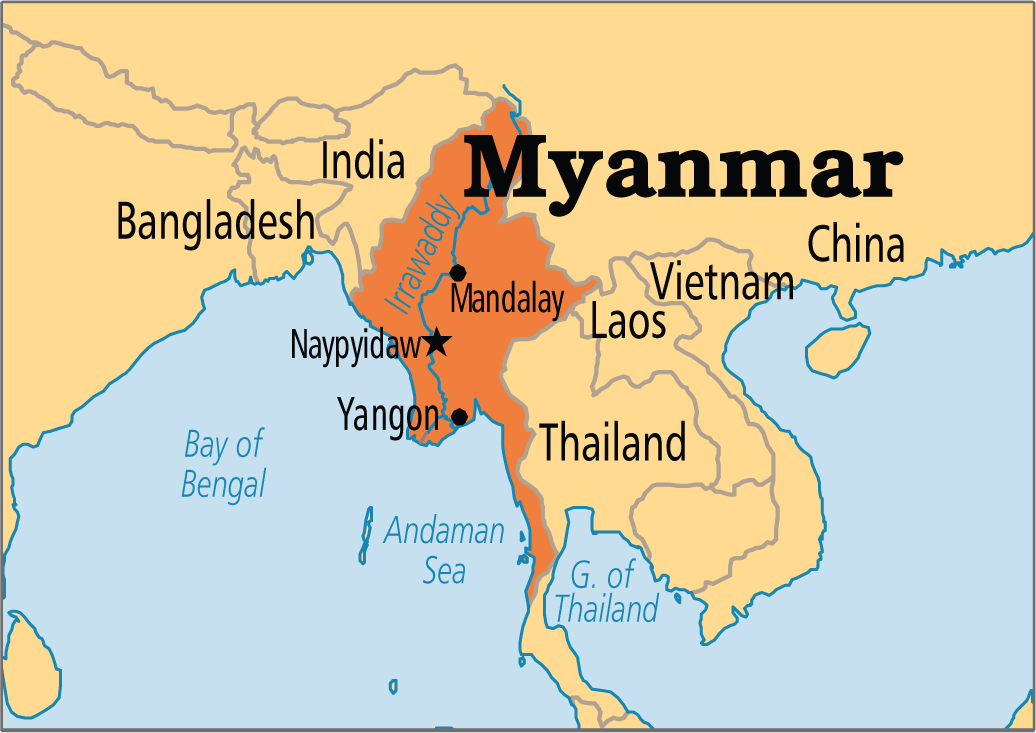-

-

- DESTINATION
-

- Myanmar
Myanmar
Myanmar is Asia at its best. More than any other Asian country, Myanmar, formerly known as Burma, has preserved its cultures and traditions. Myanmar is a deeply religious Buddhist country and is well known by travelers for its abundance of sights and sounds, in-teresting cultures, diversity of nature and most of all for its charming and friendly people. A kind of magic shrouds the whole land with its tropical plains, the Himalayan Highlands, teak-filled jungle and the Ayeyarwady River.
With an area of 671.000 square kilometers, Myanmar is almost twice as big as Germany or the state of Arizona. It is sandwiched between India and Bangladesh on one side and China, Laos and Thailand on the other. To the south is the Andaman Sea with beautiful unspoiled beaches. The Himalayas rise in the north, where the Hkakabo Razi, right on the border between Myanmar and Tibet, is the highest mountain in South-East Asia at 19,290 ft./5881m.

Climate
Myanmar has three quite distinct seasons, although the effects of the monsoon vary in different parts of the country. The best time to visit Myanmar is the ‘cool winter’ season from November to February. At this time of year the weather is very pleasant - not too hot in the day and not too cool at night. In the hills it can get quite chilly in the evenings. During March, April and May the temperatures rise and will often topping 100°F/40°C and it can be unpleasantly hot. The rainy season starts in May with almost daily monsoon rainfalls, mainly in the afternoons and evenings, until the rain tapers off in October.
Agriculture
An estimated 30 percent of the land is arable but only half of this is under cultivation. Nevertheless, agriculture is the most important sector of the economy in Myanmar - two-thirds of the employed population works in agriculture. Agricultural products are rice, maize, wheat, pulses, peanuts, sesame, sugar-cane, jute, tobacco and cotton.
Forestry
More than half the country is covered with nearly impenetrable forests but illegal fire clearances are reducing and destroying this invaluable natural resource rapidly. Myanmar is one of the most important exporters of teak wood and hardwoods and it is estimated that more than three-quarters of the world's reserves of teak wood are located in the forests of Myanmar. Smuggling of teak, and hardwoods, especially to Thailand's borders is a serious problem.
History
The tribal communities of the Karen, Mon and different Tibeto-Burmese tribes, the most famous being the Pyu (who came from eastern Tibet) were probably the first inhabitants of the area which is now Myanmar.
In the 8th century the Pyu built a town named Pyay, which was said to be the biggest in the country. The ruins of Pyay are still visible today. After the decline of Pyay the capital shifted to Bagan. From the 11th to 13th centuries about 13,000 temples and pagodas were built. King Anawratha, the first Burmese king, ruled in Bagan from 1044 to 1077 and succeeded in establishing a strong and powerful kingdom. After defeating the Mon, he took Mon prisoners back to his capital and used their architectural abilities for further development of the city. He also adopted Theravada Buddhism from them and began to spread it in his kingdom.
During the reign of King Narasihapati in the 13th century, the Mongols attacked Myanmar. The Mongols finally won the war, and in 1287 Bagan was destroyed. From the 13th to 18th centuries five independent kingdoms existed, sometimes concurrently: In-Wa, Toungoo, Rakhine, Bago and Pyu.
Alaungpaya, who came to be one of the national heroes of Myanmar, established the new Burmese kingdom in 1753. He drove the Mon out of northern Myanmar and made Shwebo his capital. Finally, in 1755, he conquered Pyay and Dagon, changing its name to ‘Yangon’ (‘end of conflict’).
In 1824, the first British-Burmese war started. In 1886, Myanmar finally lost its independence and became a province of British-India. It was centrally governed, and traditional Burmese culture was suppressed in many ways.
In the 20th century, opposition to the British occupying forces and the Karen, who supported them, grew. In 1936, after many years of opposition, elections were held and in 1937 Myanmar achieved self-government within the British Empire.
After the Second World War, the British left Myanmar, which had been proclaimed independent by the Japanese in 1943. In 1947, a new constitution was ratified and in 1948 the ‘Union of Burma’ was established.





















